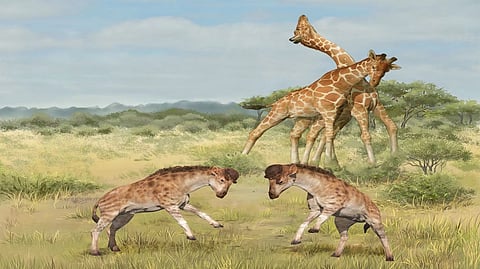

CHENNAI: Since the days of Charles Darwin, the long necks of giraffes have been a textbook example of evolution. The theory goes that as giraffe ancestors competed for food, those with longer necks were able to reach higher leaves, getting a leg — or neck — up over shorter animals. But a bizarre prehistoric giraffe relative reveals that fighting may have driven early neck evolution in addition to foraging. In a study published Thursday in Science, a team of paleontologists described Discokeryx xiezhi, a giraffe ancestor, as having helmet-like headgear and bulky neck vertebrae. Discokeryx was adapted to absorb and deliver skull-cracking collisions to woo mates and vanquish rivals.
“It shows that giraffe evolution is not just elongating the neck,” said Jin Meng, a paleontologist at the American Museum of Natural History and co-author of the new study. “Discokeryx goes in a totally different direction.”
Dr. Meng and his colleagues discovered the fossils in an outcrop of rock in northwestern China called the Junggar Basin. Around 17 million years ago, this area was an expanse of savannas and forests home to an array of large mammals like shovel-tusked elephants, short-horned rhinoceroses and burly bear dogs.
While exploring this bone-bed in 1996, Dr. Meng stumbled across a hunk of skull. He could tell it was a mammalian braincase, but the top was flattened like an iron press. Without more of the animal’s skeleton, Dr. Meng and his colleagues referred to it as the “strange beast.”
In recent years, more fossilised material — like teeth and jaw fragments — began to surface in the Junggar Basin, helping identify the beast. According to Dr. Meng, both the creature’s teeth and inner ear structure were reminiscent of modern giraffes. They determined that Discokeryx was one of the earliest graffids, an ancestral group of hoofed mammals that gave rise to giraffes. Discokeryx likely resembled an okapi, a forest-dwelling cousin of modern giraffes.
Its neck was long, but nothing like a modern giraffe’s, and researchers have yet to pinpoint how the animal’s anatomical features connect with its counterparts today. Still, Discokeryx was distinguished by its bizarre skull. According to Shi-Qi Wang, a paleontologist at the Chinese Academy of Sciences and another author of the study, the saucer-like bone capping the animal’s head was probably sheathed in keratin. As the keratin grew, older layers were pushed out, forming a thick dome. This made Discokeryx look like it was wearing a poorly fitting bicycle helmet.
This bony cap was anchored to dense vertebrae in the animal’s neck. When it came time to butt heads, the vertebrae locked together into a column perpendicular to the head dome, forming a literal battering ram. Head-butting is an ancient and widespread form of conflict resolution. Dinosaurs like Pachycephalosaurus had sturdy skulls, and knocking heads remains common in bighorn sheep, chameleons and even whales.
While it appears that some of the earliest giraffe relatives like Discokeryx were built more for fighting than foraging, they still had a specialised diet. Although they were unable to reach the treetops, chemical analyses of Discokeryx’s teeth revealed that the ancestral giraffe occupied a distinct ecological niche.
Are you in Chennai? Then click here to get our newspaper at your doorstep!
Visit news.dtnext.in to explore our interactive epaper!
Download the DT Next app for more exciting features!
Click here for iOS
Click here for Android